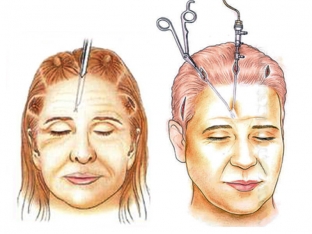As you know, facial expressions – it is the best way to convey human emotions. The forehead is one of the areas of the face that very clearly demonstrates what a person is feeling and experiencing at the moment. It is thanks to facial expressions that with age the face becomes covered with a kind of "web"; - mimic wrinkles. These wrinkles, being the main sign of aging, distort the face, adding years to it. In modern aesthetic surgery, one of the most effective ways to eliminate these wrinkles is endoscopic fronto-temporal lifting – modern forehead lift method.
Key steps for performing an endoscopic forehead lift
Endoscopic forehead lift allows you to eliminate wrinkles in this area using special surgical instruments. Endoscopic techniques make it possible to perform surgery as efficiently as possible, with minimal trauma to healthy tissues, while reducing the main risks of the postoperative period. Endoscopic fronto-temporal lifting is performed in several stages: marking, administration of anesthetics and making incisions, formation of an optical cavity, manipulation of the glabella muscles, as well as movement and fixation of the fronto-temporal flap.
Endoscopic Forehead Lift:
- First stage forehead lift: incisions and creation of an optical cavity;
- second stage of forehead lift: glabella muscle manipulation;
- Third stage of forehead lift: relocation and fixation of the flap.
First stage forehead lift: incisions and creation of an optical cavity
At the first stage of forehead lift surgery, it is important to properly perform anesthesia, make incisions and form an optical cavity, since all these manipulations determine the further course of the surgical intervention. Marking and incisions are made in the following scalp areas:
- two paramedial incisions - along lines that are drawn vertically at the level of the medial corners of the eyes;
- two lateral incisions – along vertical lines through the lateral corners of the eyes;
- two temporal incisions are made perpendicular to the line drawn through the base of the wing of the nose and the lateral corner of the eye, retreating from the hairline at the temple by 1.5-2 cm.
Tissue dissection depth levels can be different: subcutaneous, subaponeurotic, subperiosteal and combined. The simplest, safest and most effective is the combined technique: detachment of the periosteum in the frontal region with its subsequent dissection in combination with sub-SMAS dissection in the temporal region along the deep temporal fascia.

Second stage of forehead lift: glabella muscle manipulation
The volume of surgical intervention on the glabella muscles primarily determines the naturalness and harmony of the result of an endoscopic forehead lift. The depth and direction of wrinkles is determined before the operation, taking into account the individual characteristics of each patient. At this stage of surgery, it is extremely important to remember the following points:
- removal of oblique-vertical wrinkles by active resection of the muscles that wrinkle the eyebrows may eventually lead to a shift of the medial portions of the eyebrows to the sides;
- excessive resection of brow depressors and the muscles of the proud, while maintaining the intact frontal muscle, will cause the heads of the eyebrows to move upward, while over the years this condition will only worsen.
Third stage of forehead lift: repositioning and fixation of the flap
Provided adequate mobilization of the frontal and temporal parts of the flap, its displacement under the action of gravity occurs automatically. The flap is fixed in the frontal region using removable or permanent fixators, as well as in the temporal regions. The hairline is a reference point for the location of the sutures on the flap. The sutures are applied sequentially: the first suture fixes the new position of the tail of the eyebrow, the second and third – lateral or vertical shift of the entire temporal flap. The edges of the skin wounds are closed with a surgical stapler. With a competent forehead lift, taking into account all the anatomical features of the patient, the operation allows you to achieve the maximum aesthetic result.







Add a comment